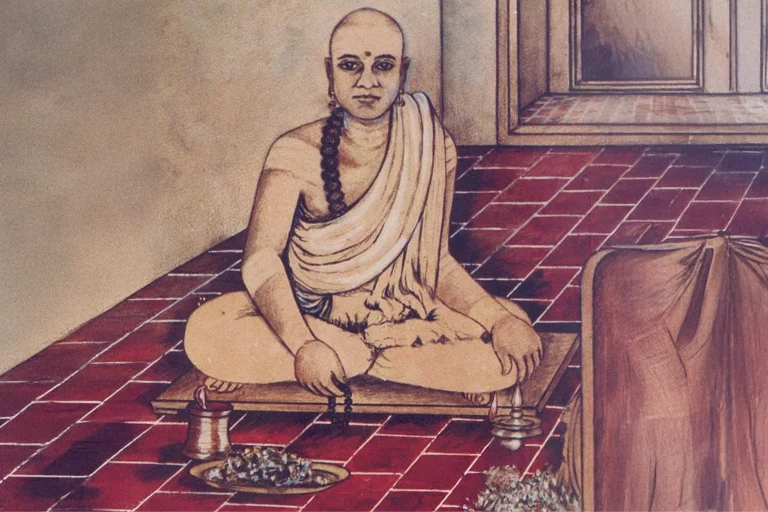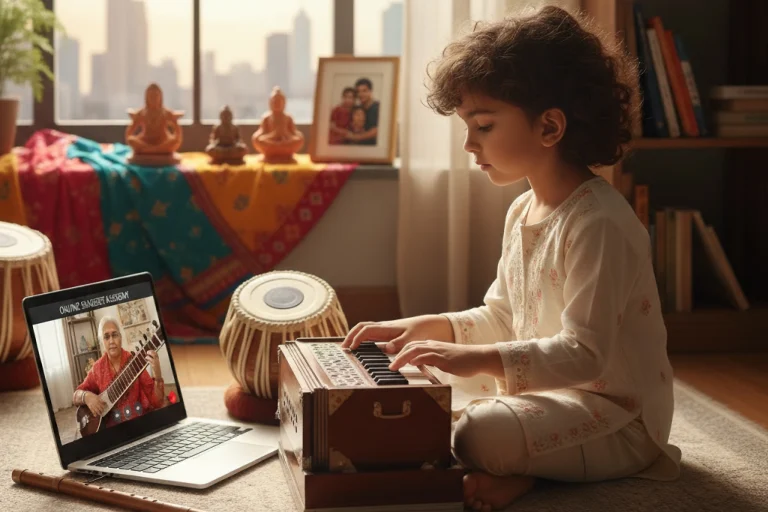All Topics
- Alchemizing Music Concepts for Students
- Artist Spotlight
- artium gift card
- Artium Maestros
- Artium News
- buying guide
- Carnatic Music
- Devotional Music
- Editorials by Ananth Vaidyanathan
- Film Music
- Guitar
- Hindustani Classical Music
- Indian Classical Music
- Indian Folk Music
- Insights
- Instruments
- Karaoke Singing
- Keyboard
- Kids Music
- maestros
- Music Education
- Music for Kids
- Music Industry
- Music Instruments
- Music Legends
- Music Theory
- Music Therapy
- Piano
- piano guide
- Success Stories
- Tamil Film Music
- Telugu Film Music
- Time Theory
- Tools
- Uncategorized
- Vocal Singing
- Vocals
- western classical music
- western music
- Western vocal music
Indian Classical Music, western classical music
Classical Music for Kids: Introduction to the World of Melody, Rhythm, and Great Composers
Classical Music for Kids: Introduction to the World of Melody, Rhythm, and Great Composers
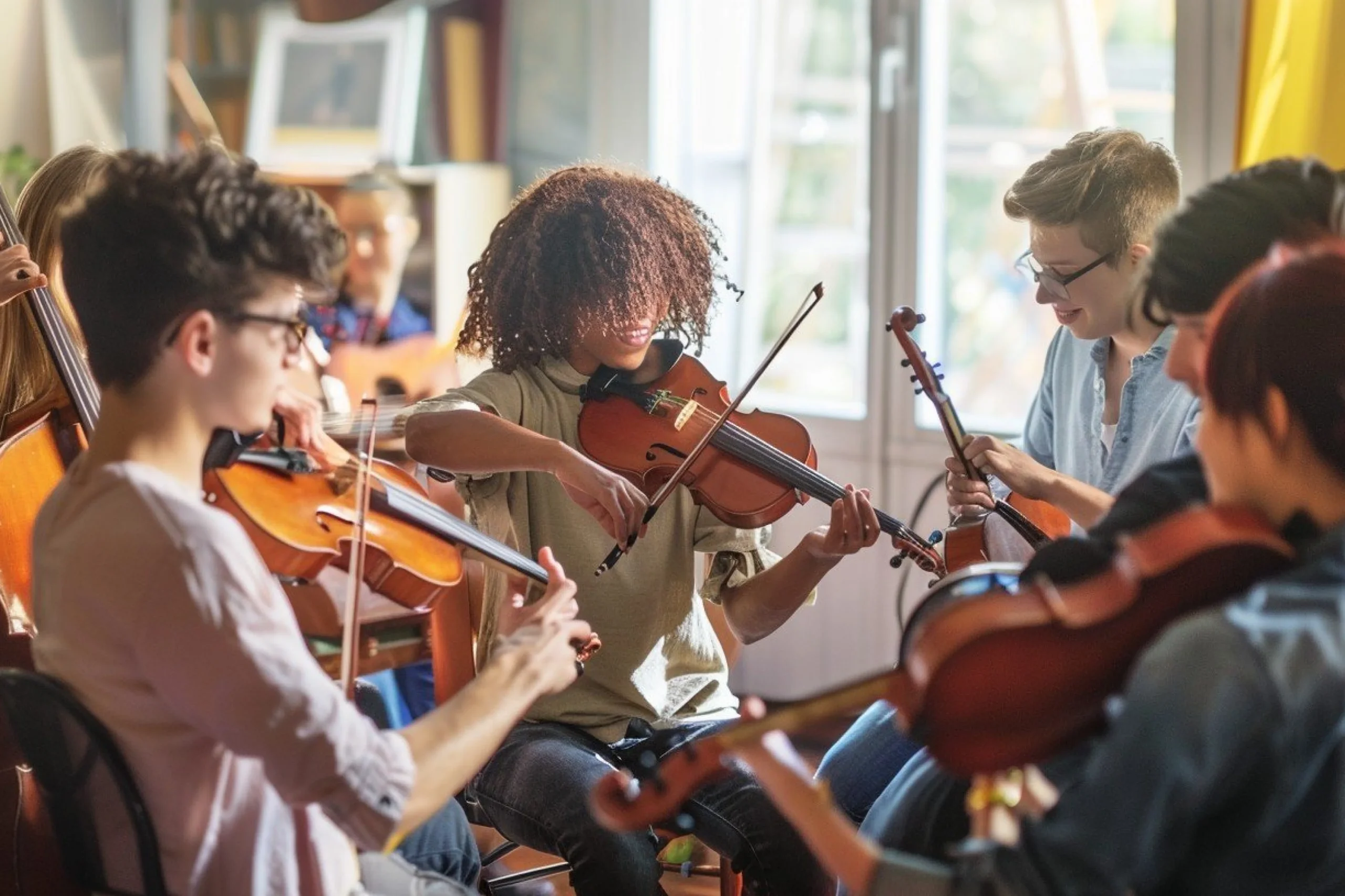
Table of Contents
Young minds are all about curiosity. From an early age, everything around them sparks curiosity, making the introduction to new sounds ideal at this stage. It gives them a new pathway into melody, rhythm, and stories conveyed through music that can light up both imagination and focus all at once.
If you want to introduce them to classical music for kids, then the earlier, the better. Because young learners begin to connect patterns with feelings, which grow into better attention, creativity, and confidence over time.
And there’s no better time to start this than in 2025. With curated playlists, kid-ready resources, and structured online music classes for kids now easily accessible, introducing your children to classical music has become easier than ever. They can begin their journey into the world of classical music right from home or in class.
Classical Music for Children: Why Does It Matter Now?
Studies show that music learning has been associated with improvements in attention span, language, and executive functioning. These foundations aid in reading, communication, and even maths as your child grows. Though it may not look much, regular listening and simple activities like clapping to beats and singing call & response lines strengthen neural circuits for timing and coordination.
This results in learning readiness and emotional self-regulation. So, if you’re looking for ways to introduce kids to classical music, go for songs with a slower tempo and predictable phrasing. It can help in slowing down the routines, transitions, and homework focus without overstimulating them.
The Power of Early Exposure to Classical Music
Introducing children to classical music can deepen their emotional intelligence. It gives them a way to practice naming feelings, hearing contrasts (loud/soft, fast/slow), and identifying changes in tone color. Not just that, it is a great way to open them to a world full of music. From Beethoven to Tyagaraja, the conversations about music history and place can feel familiar and welcoming to them.
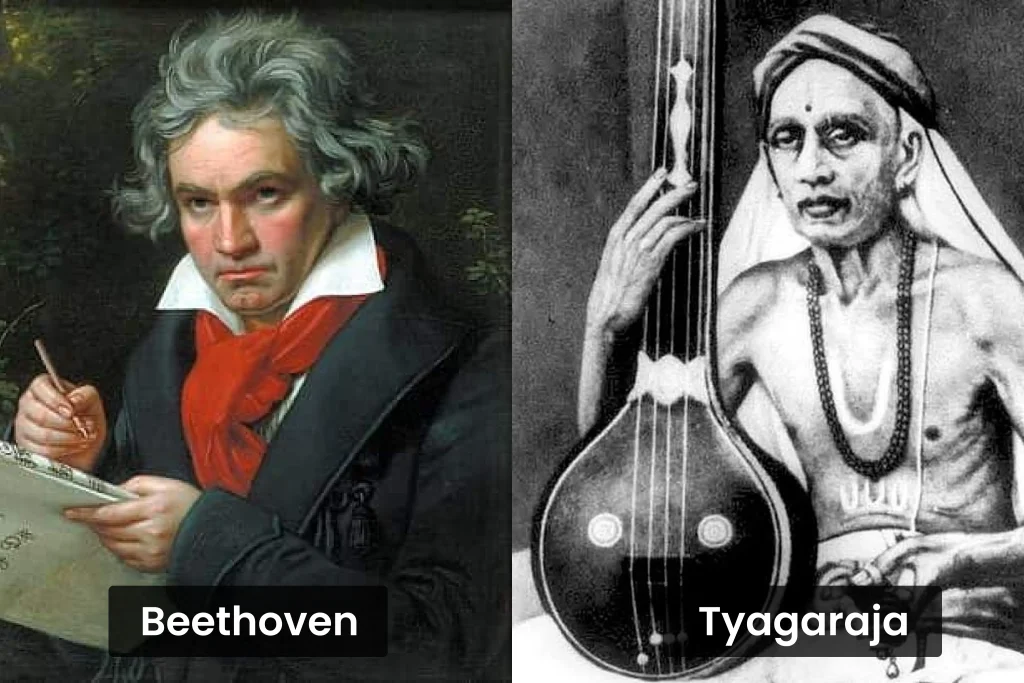
So, if you’re finding ways to introduce kids to classical music, then it starts with one short piece a day. Sooner or later, it grows into a habit that they request on their own because it feels both relaxing and fun.
Benefits of Classical Music to Young Children
Benefits of Classical Music (Indian and Western) to young ones include:
- The reinforcement of rhythm and repetition in musical practice aids in strong focus and working memory during reading and homework.
- Musical storytelling and expressive dynamics can enhance creativity and imaginative play.
- Calmer routines and smoother transitions with soothing, predictable music during evenings or study time.
- Curiosity and literacy about places and people after hearing music by famous composers across eras.
Indian Classical music and Western Classical, Side by Side
Indian classical music, including Hindustani classical & Carnatic classical and Western classical traditions, has been around for a long time. They are structured systematically, are endlessly creative, and can be easily enjoyed by kids from the start. Indian classical music revolves around raga (melodic framework) and tala (rhythmic cycle), while Western classical music has melodies and harmonies with written scores and ensemble coordination. Both are different, but they help children understand how sound, shape, and time are used in music.
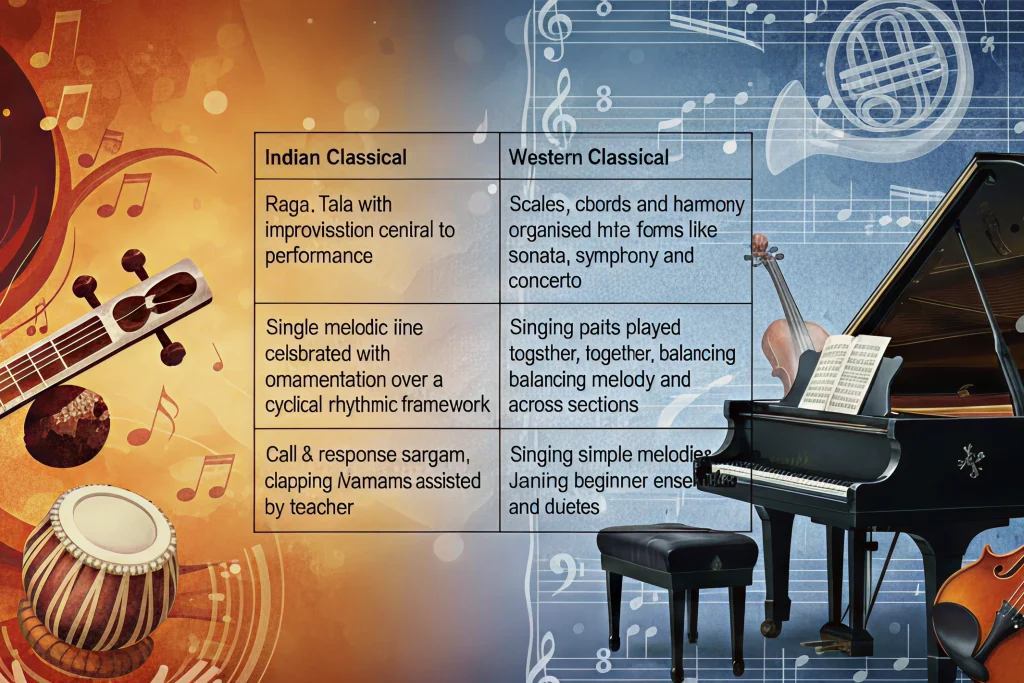
Ways to Introduce Kids to Classical Music
- Start with one expressive piece per day. Ensure it is short, like about 2 – 4 minutes, as they may have shorter attention spans.
- To maintain curiosity, ask questions like, “What instrument did you hear first?” or ”How did music change from start to finish?”
- Keep changing between Indian classical and Western classical songs to keep timbres, textures, and forms feeling new.
- Use calming classical songs for kids in the evening. Gentle piano or strings supported wind-down rituals and better sleep cues.
- Explore BBC Ten Pieces films and classroom-ready activities that are designed to make classical music enjoyable for young children.
A Starter Listening List Kids Love
Here is the list of calming classical music for kids. These songs are composed by famous musicians and are renowned around the world.
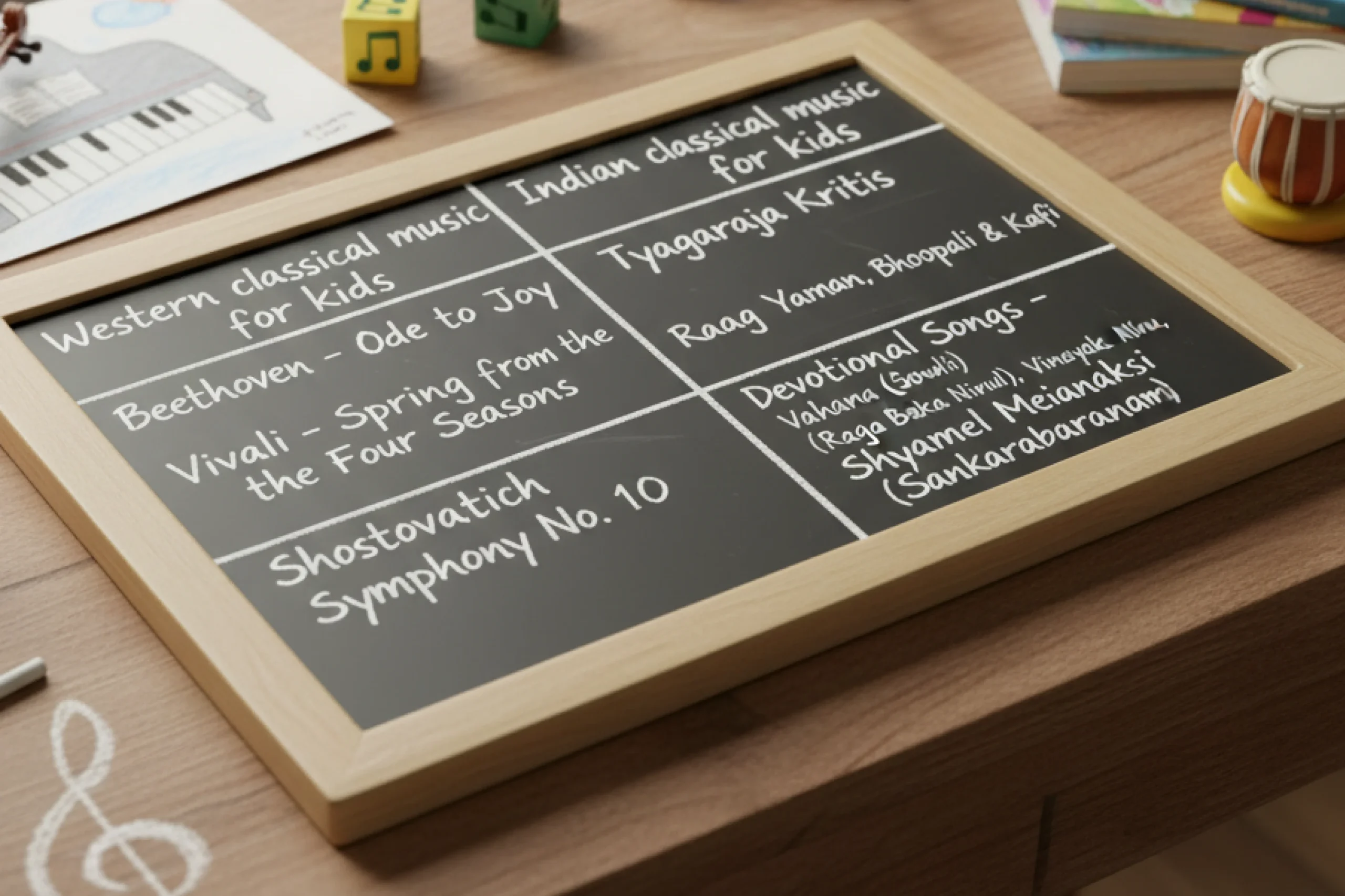
Learning By Doing: Hands-On Matters
The best way to learn something is to practice it. The same goes for singing or teaching instruments. You can introduce your kid to child-friendly instruments that will help their small hands succeed without strain or frustration.
Keyboards and pianos give instant pitch feedback while percussion (hand drums, shakers) helps in building pulse and coordination before moving into table or mridangam cycles. If your kid is drawn to singing, then singing games, sargam (solfege), and echo patterns can help in building pitch awareness, all the while keeping sessions short and active.
Beginner Paths That Work In 2025
- Indian classical music for kids: To start your child’s musical journey in Indian classical music, begin with simple sargam call & response, clapping talas. Also, try short bandish or varnam specially designed for young voices.
- Western classical music for kids: Start with one-line melodies, simple rhythms, and note-to-note activities before full notation reading.
- Online music classes for kids: They offer interactive lessons, progress tracking, and bite-sized tasks that fit your family’s schedules while maintaining structure.
Great Composers As Musical Storytellers
You know what’s the best part about young children? It’s their curious minds, and that’s why introducing them to great composers can transform their journey into captivating stories filled with people, places, and challenges.
For example, we all know Beethoven was deaf. But his resilience and dedication to his craft teach kids how effort and determination lead to achievement. His big feelings, clear motifs, and triumphant finales give them a chance for theme recognition and singable melodies that kids can remember and enjoy.
Even composers like Purcell and Tchaikovsky make their music accessible and emotionally relevant to younger audiences by creating short, emotionally direct movements. This helps them feel and identify changes in mood and tempo. The BBC’s Ten Pieces program offers engaging video shorts and interactive activities, making this narrative storytelling approach practical and enjoyable to implement at home or in school settings, turning composer discovery into an adventure rather than a lesson.
Likewise, listening to Tyagaraja kritis opens up a conversation about purpose and spiritual intent in musical performance. His musical compositions teach children how improvisation and devotion can beautifully shape a musical piece.
Building Daily & Lasting Musical Habits
Like everything else, consistency is the key to success here, too. It is better to practice 3 minutes a day rather than practice once a week. You can get them habituated by clubbing listening with existing routines like breakfast, car rides, or after homework to reinforce that music is a regular, enjoyable part of everyday life.
Doing this over time leads to a deeper concentration, a richer vocabulary for feelings, and more resilient study habits. As a parent, you can do the following to keep the magic of classical music for kids alive:
- Keep the session short and sweet to build trust and momentum
- Ask one feeling word: happy, calm, excited – naming emotions builds emotional awareness
- Ask them to participate: clap, hum or tap – it’ll keep them engaged
- Celebrate small wins to keep them motivated
How Can Artium Help in Classical Music for Kids?
At Artium, we understand the transformative power of music through our online music classes. We deliver classical music for kids by blending India’s finest maestros with intuitive online tools to make every lesson engaging. Handpicked by our maestros, our live, 1:1 music classes connect our learners to some of India’s top music educators.
Each lesson is enriched with features like adjustable metronomes, slow-motion playback and recordings to allow our students to master tricky rhythms and melodies at their own pace. As a parent, you can track their progress through our progress tracker, which shows clear, visual milestone charts, customised to your child’s goals.
We are India’s first and only music learning platform offering Ofqual-accredited music courses as part of our Globally Recognised Music Programme (GRMP). By joining Artium Academy, your child will advance through structured levels, learning sargam, tala cycles, notation reading, and ensemble performance, with assessments designed to celebrate small wins and maintain motivation.
With 30,000+ music learners worldwide, we are not just a leading online music learning platform, but a vibrant community where your child’s musical journey is supported, measured, and honored across borders. Your young musician gains more than skills and certificates; they build lifelong appreciation, discipline, and joy in classical music.
Growing with Classical Music
Classical music can open doors to a world of possibilities where melody and rhythm spark imagination, focus, and emotional growth. The magic of classical music for kids lies in its ability to blend creativity with discipline, whether through soothing piano notes or playful ragas designed for young ears. By creating an intrigue about Indian classical music for kids and Western classical music for kids, you can improve your child’s study habits and build confidence.
Through our online music classes for kids, you can give your child access to structured, interactive lessons that teach them simple sargam patterns to master Beethoven’s clear motifs and Tyagaraja’s devotional kritis. As the best classical music for kids, our courses offer live maestro-led masterclasses, progress tracking, and globally recognized certification.
Enroll today to give your child the gift of classical music and inspire a lifelong passion for music.
FAQs on Classical Music for Kids
The most important thing to remember while introducing your child to classical music is to make it a natural and joyful part of their life. Ask them simple questions like “what instrument do you hear?” or “how music changed from start to end?” The magic of classical music for kids unfolds when you tie listening to existing routines like breakfast, car rides, or after homework, making music feel like a regular, enjoyable part of everyday life.
Raga is the melodic framework that forms the foundation of Indian classical music, providing a specific set of notes and patterns that create distinct moods and emotions. Unlike Western scales, ragas are living musical structures that guide improvisation and expression within defined boundaries. For example, Raga Yaman creates an evening devotional mood, while Raga Bhupali offers a joyful, five-note pentatonic structure perfect for beginners. Melody, in both Indian and Western contexts, refers to the main tune or musical line that listeners can sing or hum. In classical music for children, melodies serve as memorable pathways into understanding rhythm, pitch relationships, and emotional expression—whether through Beethoven’s clear motifs or Tyagaraja’s devotional kritis.
The best approach to classical music to young children combines listening, participation, and hands-on exploration. Begin with child-friendly instruments like keyboards for instant pitch feedback or simple percussion instruments like hand drums to build pulse and coordination. For voices drawn to singing, use sargam (Indian solfège) exercises, echo patterns, and singing games that build pitch awareness while keeping sessions short and active. Online musical classes for kids offer structured learning with interactive lessons, progress tracking, and bite-sized tasks that fit family schedules. The key is celebrating small wins—finishing a short melody or keeping a steady beat represents real progress that builds confidence and motivation for continued musical exploration.
Indian classical music centers around raga (melodic frameworks) and tala (rhythmic cycles), with improvisation playing a central role in performance. The listening focus emphasizes a single melodic line elaborated with ornamentation over cyclical rhythmic patterns. Western classical music organizes scales, chords, and harmony into structured forms like sonatas, symphonies, and concertos, with multiple parts played together to balance melody and accompaniment across sections. Both traditions help children understand how sound, shape, and time work in music, though through different approaches. For beginners, Indian classical music for kids starts with call-and-response sargam and clapping talas, while Western classical music for kids begins with simple melodies, basic notation reading, and beginner ensemble participation.
Artium Academy stands as India’s premier destination for classical music for kids because we blend maestro-curated & Ofqual-accredited courses with cutting-edge online tools to make every lesson engaging and effective. With 30,000+ learners worldwide, interactive features like adjustable metronomes and progress tracking, and live 1:1 classes, we create a vibrant learning community where your child’s musical journey is supported, measured, and honored across borders.
Classical music for kids represents age-appropriate introductions to both Indian and Western classical traditions that spark imagination, focus, and emotional growth. The best classical music for kids includes carefully selected pieces like Beethoven’s “Ode to Joy,” Vivaldi’s “Spring,” simple Tyagaraja kritis, and devotional songs like “Mooshika Vahana,” all of which offer memorable melodies and clear emotional narratives. Classical songs for children are structured to build attention spans, creativity, and cultural literacy while providing calming routines and smoother transitions during study time. This includes both the systematic beauty of ragas and talas in Indian traditions and the harmonic richness of Western symphonies and concertos, all adapted to support young learners’ developmental needs and natural curiosity.
The ideal time for introducing children to classical music is as early as possible, with different approaches suitable for various developmental stages. For ages 3-6, focus on simple listening activities, basic rhythm games, and exposure to calming classical music for kids through daily routines. Ages 7-10 represent an excellent starting point for formal online musical classes for kids, where children can begin structured learning of sargam, basic notation, and simple compositions while their neural circuits for timing and coordination are still highly adaptable. By ages 11 and beyond, students can tackle more complex pieces, ensemble work, and deeper cultural exploration. The magic of classical music for kids lies in its ability to grow with the child—starting with playful exploration and evolving into disciplined practice that builds lifelong appreciation, focus, and emotional intelligence regardless of when the journey begins.



